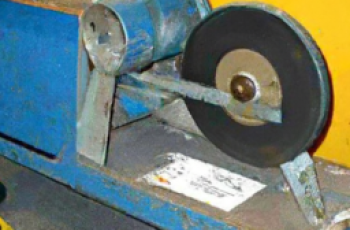Bench grinders have come a long way since their humble beginnings. Over time, they have transformed from simple grinding machines to powerful, versatile tools that are essential in every workshop. With advancements in technology, bench grinders now offer a range of features and capabilities that make them indispensable for tasks such as sharpening, shaping, and polishing. This article explores the fascinating evolution of bench grinders, highlighting the innovative changes that have shaped them into the efficient and effective tools they are today.
The Early Beginnings
Invention of the first bench grinder
The bench grinder, a versatile and indispensable tool in numerous industries and households today, has a rich history that dates back to the early 19th century. While the exact inventor of the first bench grinder remains unknown, it is believed to have been developed in Europe as a hand-operated machine to facilitate various grinding tasks. The invention of the bench grinder revolutionized grinding processes and paved the way for the development of more advanced models in the years to come.
Historical context
The invention of the bench grinder took place during a time of great technological advancements and industrial growth. The Industrial Revolution, which began in the late 18th century, brought about significant changes in manufacturing processes and the use of machinery. This period witnessed a shift from manual labor to machinery, leading to increased productivity and the need for more efficient grinding tools. The bench grinder emerged as a valuable tool during this era to meet the growing demands of industries.
Early design features
Early bench grinders were simple in design yet highly functional. They consisted of a motor-driven grinding wheel mounted on a sturdy base. The grinding wheel was usually made of natural abrasive materials like sandstone or emery, which were effective in sharpening tools and shaping materials. These early models were generally operated manually, with the user applying pressure to the workpiece against the rotating wheel. While lacking in some modern features, these early bench grinders were nonetheless effective in completing a range of tasks.
Industrial Revolution Impact
Introduction of electricity
One of the most significant turning points in the evolution of bench grinders was the introduction of electricity. With the widespread adoption of electricity during the late 19th century, bench grinders were able to transition from hand-driven to electrically-powered machines. This marked a substantial improvement in terms of efficiency and convenience, as it eliminated the need for manual labor and enabled faster grinding operations.
Adoption in industrial settings
The industrial sector quickly recognized the benefits of bench grinders and embraced their use on a large scale. These machines became widely incorporated into various industrial processes, including metalworking, woodworking, and fabrication. Bench grinders proved to be invaluable tools in shaping and polishing metal parts, sharpening cutting tools, and ensuring precision in manufacturing. Their adoption in industrial settings resulted in significant improvements in efficiency and productivity.
Increased efficiency and productivity
With the growing implementation of bench grinders in industrial environments, their design and functionality underwent continuous improvements. The addition of electric motors allowed for higher rotational speeds, reducing the time required to achieve desirable results. Moreover, the introduction of grinding wheels made of durable bonded abrasives greatly enhanced the efficiency and longevity of bench grinders. These advancements in design and materials significantly increased the overall productivity in grinding processes.

Advancements in Materials and Technology
Incorporation of stronger materials
As industries continued to evolve, the demand for more robust bench grinders also increased. Manufacturers responded by incorporating stronger and sturdier materials, such as cast iron and steel, into the construction of bench grinders. This ensured greater durability and enabled the machines to withstand heavy use in demanding industrial environments. The use of these stronger materials resulted in more reliable bench grinders that could withstand the rigors of industrial applications.
Development of better grinding wheels
The evolution of bench grinders also involved advancements in the technology and materials used to manufacture grinding wheels. Early abrasive materials, such as sandstone and emery, were gradually replaced by more efficient and durable materials like aluminum oxide and silicon carbide. These new abrasives offered enhanced grinding performance and allowed for greater precision. Additionally, improvements in bonding techniques ensured that the abrasive material remained securely attached to the grinding wheel, minimizing the risk of detachment during operation.
Integration of safety features
With the increasing recognition of workplace safety, bench grinder manufacturers began integrating safety features into their designs. This included the introduction of safety guards, which helped protect the operator from flying debris and sparks generated during the grinding process. Bench grinders also started featuring emergency stop buttons, enabling quick shutdown in case of any unforeseen accidents. These safety measures aimed to reduce the risk of injuries and ensure that bench grinders could be used with confidence in various work environments.
Shift to Consumer Market
Availability for home use
While bench grinders were initially designed for industrial use, their potential applications in domestic settings soon became evident. As household tasks such as tool sharpening, rust removal, and small-scale metalworking began to emerge, manufacturers recognized the opportunity to cater to the consumer market. This led to the availability of compact and affordable bench grinder models specifically designed for home use.
Features targeted for DIY enthusiasts
The shift towards the consumer market prompted manufacturers to incorporate features that appealed to DIY enthusiasts and hobbyists. These features included adjustable tool rests, which enabled precise angle settings for optimal tool sharpening. Additionally, some bench grinders offered multiple grinding wheel options to accommodate various materials and tasks. Such enhancements allowed individuals to explore their creativity and undertake a wider range of projects with ease and convenience.
Growth of the hobbyist market
The introduction of bench grinders in the consumer market contributed to the growth of the hobbyist market. DIY enthusiasts, craftsmen, and artists embraced the versatility of bench grinders, realizing their potential in creating intricate designs and achieving professional-looking finishes. This expansion of the hobbyist market further motivated manufacturers to innovate, creating more user-friendly and specialized bench grinder models tailored to the specific needs of this burgeoning customer base.

Precision and Versatility
Introduction of variable speed control
To meet the evolving demands of users, bench grinder manufacturers introduced variable speed control in their machines. This innovation allowed individuals to adjust the rotational speed of the grinding wheel, enabling greater precision and control over the grinding process. Variable speed control proved particularly valuable when working with delicate materials or when aiming for exceptionally smooth finishes. This feature enhanced the versatility of bench grinders and expanded their applications beyond traditional grinding tasks.
Inclusion of different grinding attachments
To further enhance the versatility of bench grinders, manufacturers began incorporating different grinding attachments into their designs. These attachments included wire wheels for rust removal, buffing wheels for polishing, and sharpening jigs for precise tool sharpening. By offering a range of specialized grinding attachments, bench grinders became more adaptable to a variety of tasks, catering to the needs of professionals and DIY enthusiasts alike.
Enhanced accuracy for intricate work
Advancements in technology and manufacturing techniques led to increased accuracy and precision in bench grinder designs. Tighter tolerances, improved motor control systems, and better balance mechanisms ensured smoother and more consistent grinding operations. These enhancements allowed users to tackle intricate work with confidence, achieving fine details and smooth contours. The precision offered by modern bench grinders opened up new possibilities for artists, craftspeople, and professionals requiring meticulous results in their work.
Ergonomics and User-Friendly Design
Improved handle and control placement
Manufacturers recognized the importance of ergonomics and user-friendly design in bench grinders. They incorporated more comfortable handles and strategically positioned controls to ensure ease of use and reduce operator fatigue. Ergonomic improvements enhanced the overall user experience, enabling longer periods of operation without discomfort. By prioritizing user comfort, manufacturers made bench grinders more accessible to a wider range of individuals, improving their usability in both professional and domestic settings.
Enhanced vibration reduction
Vibration is a common issue in bench grinders that can cause discomfort and affect the quality of work. To address this, manufacturers developed innovative solutions to minimize vibration, ensuring a more pleasant and efficient grinding experience. These included the use of advanced motor suspension systems and vibration-dampening materials in the construction of bench grinders. By reducing vibration, these improvements not only increased user comfort but also improved the accuracy and precision of grinding tasks.
Integration of dust collection systems
The incorporation of dust collection systems became a key feature in modern bench grinder designs. Dust and debris generated during grinding can be hazardous to health and detrimental to the performance of the machine. To mitigate these issues, manufacturers introduced effective dust collection systems that captured and contained airborne particles. This not only ensured a cleaner work environment but also improved the longevity and performance of bench grinders by preventing the buildup of debris and abrasive materials.

Safety Measures and Regulations
Development of safety guards
Safety guards have been a significant addition to bench grinders, designed to protect operators from potential hazards. These guards are positioned around the grinding wheel, preventing contact with the wheel surface while retaining visibility of the workpiece. Manufacturers have continuously improved the design of safety guards, ensuring effective protection without obstructing the grinding process. The implementation of safety guards has played a crucial role in reducing the risk of injuries and ensuring safer operation of bench grinders in both professional and domestic settings.
Implementation of OSHA guidelines
In response to growing safety concerns, regulatory bodies such as the Occupational Safety and Health Administration (OSHA) have issued guidelines and regulations regarding bench grinder usage. These guidelines provide recommendations on equipment design, work practices, and personal protective measures to ensure the safe operation of bench grinders. Manufacturers have embraced these guidelines and incorporated them into their designs, doing their part to ensure compliance and promote workplace safety.
Importance of eye protection
Since grinding operations generate sparks and debris, eye protection is essential to prevent eye injuries. To raise awareness about the potential risks and the importance of eye protection, manufacturers have emphasized the need for proper safety goggles or face shields. They have also developed safety features such as transparent spark shields to provide an additional layer of protection. By prioritizing eye safety and promoting the use of appropriate protective gear, bench grinder manufacturers contribute to the overall safety of users.
Automation and Robotics
Introduction of automated bench grinders
The advent of automation and robotics has had a profound impact on bench grinder technology. Automated bench grinders utilize computer-controlled mechanisms to perform grinding tasks, minimizing the need for human intervention. These machines are capable of precise and consistent grinding operations, making them ideal for mass production and repetitive tasks. The introduction of automation has significantly increased efficiency and productivity while reducing labor-intensive processes.
Integration with robotic systems
Automation in bench grinders has been further enhanced through the integration with robotic systems. Robotic arms and manipulators can now be used to control and manipulate the workpieces during the grinding process, ensuring optimal positioning and precision. This integration of bench grinders with robotics allows for seamless integration into complex manufacturing systems, offering unparalleled precision and productivity.
Advantages in mass production
Automation and robotics have revolutionized the industrial sector, particularly in mass production. With automated bench grinders, manufacturers can achieve consistent and high-quality results even at high production volumes. The elimination of human error and the ability to program specific grinding parameters contribute to the reduction of waste and ensure uniformity across manufactured products. The advantages offered by automated bench grinders have made them invaluable assets in industries that prioritize efficiency and precision.
Environmental Considerations
Transition to more eco-friendly materials
In recent years, there has been a growing emphasis on sustainability and environmentally friendly practices. Bench grinder manufacturers have responded to this by transitioning to more eco-friendly materials in their machines. This includes the use of recycled materials like steel and aluminum, as well as the incorporation of biodegradable components wherever possible. By adopting these practices, manufacturers contribute to reducing their carbon footprint and minimizing the environmental impact of bench grinder production.
Reducing energy consumption
Energy efficiency has become a significant focus in the development of bench grinders. Manufacturers have implemented energy-saving technologies, such as high-efficiency motors and motor control systems, to minimize power consumption. Additionally, incorporating features like automatic shut-off or sleep modes when the machine is not in use further contributes to energy conservation. These efforts align with the global push for energy efficiency and help reduce the environmental impact associated with bench grinder operations.
Waste management and recycling initiatives
Waste management and recycling have become integral considerations in bench grinder production. Manufacturers have implemented strategies to reduce waste generation during the manufacturing process, such as optimizing material usage and recycling scrap materials. Additionally, manufacturers encourage responsible disposal and recycling of bench grinders at the end of their lifecycle. These waste management and recycling initiatives contribute to the circular economy, minimizing landfill waste and conserving valuable resources.
Future Trends and Innovations
Wireless and cordless technology
As technology continues to advance, the concept of wireless and cordless bench grinders has emerged. These innovative designs eliminate the need for power cords, providing greater flexibility and convenience. The integration of rechargeable batteries allows users to operate bench grinders without restrictions, making them ideal for remote locations or areas without readily available power sources. Wireless and cordless bench grinders are expected to become increasingly prevalent as battery technology continues to improve.
Integration with smart devices
The rise of smart devices and the Internet of Things (IoT) has opened up new possibilities for bench grinder functionality. Integration with smart devices allows users to monitor and control their bench grinders remotely through smartphone applications or voice commands. This connectivity enables real-time monitoring of grinding parameters, status updates, and even automatic adjustments based on pre-programmed preferences. The integration of smart technology enhances user convenience and provides greater control and customization options.
Advancements in grinding precision
With a continued focus on precision and accuracy, bench grinder manufacturers are continually exploring new technologies to improve the grinding process. Innovations such as computer numerical control (CNC) systems, advanced sensor technologies, and artificial intelligence are being incorporated into bench grinder designs to achieve unparalleled levels of precision. These advancements enable users to achieve highly specific and intricate results efficiently, expanding the possibilities for precision grinding across industries.
In conclusion, the evolution of bench grinders from their humble beginnings to the advanced machines we have today is a testament to human ingenuity and the constant pursuit of technological advancements. The early inventions laid the foundation for the industrial revolution, which propelled bench grinder usage in various industries. Advancements in materials, technology, and safety features contributed to increased efficiency, productivity, and user-friendly design. The transition to the consumer market brought bench grinders into homes, empowering DIY enthusiasts and hobbyists. Precision, versatility, and ergonomic improvements made bench grinders more adaptable and easier to use. Safety measures and regulations ensured the well-being of users. The integration of automation and robotics transformed bench grinders into powerful tools for mass production. Environmental considerations prompted manufacturers to adopt sustainable practices. Looking to the future, wireless technology, integration with smart devices, and advancements in grinding precision promise further innovation in the bench grinder industry. As these machines evolve, they continue to facilitate craftsmanship, improve productivity, and push the boundaries of what is possible in the world of grinding.



